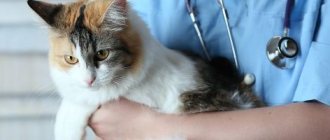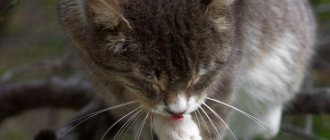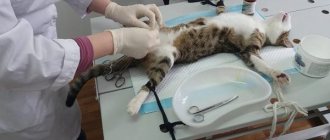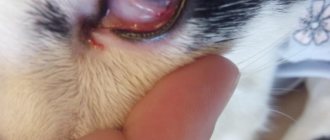Most owners consult a veterinarian about the timing of castration. This procedure helps not only lengthen the pet’s life, but also reduce the number of stray animals. Choosing the optimal age is a nuance that causes a lot of controversy among veterinarians and owners. Serious complications and even death can result from the patient being too young or old.
Feeding
During the first 2-3 weeks, you need to transfer the cat to a new diet. The transition should not take place in a few days, but over at least a month. Remember that cats have very strong food habits and have difficulty switching to new food. At the same time, you need to remember that you can feed your pet only natural food or industrial feed.
When feeding natural foods, the bulk of the diet should be meat and meat by-products. In this case, you do not need to feed the cat with selected cuts; you can use a variety of offal: lungs, bones, tripe and other offal. One of the main principles is the exclusion of fish and fatty meat, since the first leads to an increase in stone formation in the bladder, and the second leads to obesity.
When feeding with industrial food, you can purchase special products for neutered cats (labeled accordingly). Only here you need to remember that it is better to purchase food at a specialized pet store. Moreover, if you feed your cat such foods, then you should not give him food from the table.
Caring for a cat after castration
Particular attention should be paid to caring for the animal on the first day after surgery, and then its health should be carefully monitored for several days. You need to know that most of all complications appear in the first few days after surgery
First day
The cat recovers from anesthesia within 1-4 hours, it all depends on the drugs, age and surgical technique. Immediately after the return of consciousness, the pet may try to get up and go about its business, but it does not work. Usually there is a severe lack of coordination - a consequence of the effect of anesthesia on the brain.
Therefore, the cat should be left in a soft, warm, but not high place, and bowls of water and food should be placed nearby so that he does not need to jump or walk somewhere.
It is quite normal if the animal does not want to eat immediately after anesthesia; the appetite will return in the evening or the next day. But usually pets are very thirsty. Sometimes vomiting is observed, especially if the diet was not followed for 12 hours before the operation. These are completely normal phenomena and you shouldn’t worry about them, but if food refusal or vomiting occurs for more than a day, then this is a reason to consult a doctor.
First week
You should carefully care for the wound for 10-14 days, until the sutures are removed or until the wound is completely healed. You need to care as follows:
The wound and sutures are treated with antiseptic solutions; iodine, brilliant green, potassium permanganate, furatsilin and any other drugs are suitable for this. When choosing a remedy, it is better to consult a veterinarian; he will suggest more effective and modern drugs. You need to treat it carefully, do not rub the wound, but blot it with a swab or cotton wool moistened with an antiseptic substance.
To prevent the pet from licking or scratching the wound, an Elizabethan collar is placed on its head. It will limit the animal’s mobility and will not allow it to reach the wound. The design is not convenient; it often prevents the animal from moving, jumping, playing and running. But you need to be patient. The collar cannot be removed! Even if the pet has a particularly suffering look.
In addition, you need to change the cat litter daily, or better yet 2 times a day, as the wound can easily become dirty and infected with dirty litter. It is better to use clumping filler; when it absorbs moisture, it clearly differs in consistency and color from unused filler, which will allow you to clean the pot more thoroughly. Of course, if the cat’s habit of going to the potty is strong enough, then it is better to abandon the litter altogether for a while.
Caring for animals in the postoperative hours
The duration of the operation is no more than 20 minutes, after which the animal must remain in the clinic under the supervision of a doctor for an hour. This is necessary because anesthesia can cause breathing to stop. In an hour you will be able to pick up the cat and care for him at home.
Since castration is performed under general anesthesia, after it the animal may experience nausea, weakness, dizziness, and a strong feeling of thirst, especially in the first 3 hours. This condition is natural and should not bother the owner.
After surgery, your cat may experience the following changes in health:
- Dryness and burning in the eyes. Due to the fact that during the operation the animal’s eyes remain open, the doctor moisturizes them with a special solution. At home, the owner will also have to do this procedure.
- Low temperature. A common occurrence in the postoperative period is a decrease in the animal’s body temperature by 1-2 degrees, which is considered normal. The owner should take this into account and help the cat keep warm. If necessary, you can use a heating pad.
- General weakness. On the first day after surgery, when trying to get up, the cat may stagger due to poor coordination of movements, so you need to try to persuade him to lie down with the help of affection. You should not leave your pet unattended during the first few hours so that he does not fall while climbing to a height.
- Loss of appetite. In the first hours of the postoperative period, feeding is not recommended, as vomiting may occur.
- Pain. The doctor must write down the names of drugs that can be given to the cat after castration to relieve pain.
How to treat wounds
Postoperative care in the first 2 weeks includes:
- Conduct a visual inspection of the wound to rule out inflammation or bleeding.
- Treat the seam twice a day with hydrogen peroxide and brilliant green.
- Using Levomekol ointment for inflammation.
In the first days after castration, the pet must be in a special collar that will not allow him to lick the wound, otherwise the stitches may come apart.
Due to reduced immunity or improper care of the animal after surgery, complications and inflammation of the wound may begin. In this case, the doctor will prescribe antibiotics.
Preparing a cat for sterilization.
Sterilization of Sphynx cats is a painless operation that is performed under anesthesia. Due to the effect of the drug on the body, some cats may vomit before surgery.
This is absolutely normal, and in order not to cause harm to the body, simple preparation is required. Before surgery, the cat does not need to be fed for twelve hours. During this time, there will be no more food left in the stomach and the intestines will be freed, making it easier for the cat to enter a state of sleep.
The cat will also not be allowed to drink two hours before anesthesia. Antiparasitic treatment is recommended before sterilizing Sphynx cats. You will need to give your cat an anti-worming tablet about two weeks before surgery.
How is sterilization carried out?
Sterilization of Sphynx cats is carried out under anesthesia. First, your veterinarian will give your cat an injection to prepare for anesthesia. After it, the cat will become slightly intoxicated, its muscles will relax, and the cat itself will calm down. This is necessary to prepare her body for anesthesia.
Where is the best place to castrate a cat - in a clinic or at home?
Veterinarians perform castration of a cat both in a veterinary clinic and at the owner’s home. When using modern antiseptics, castrating a cat at home is not at all dangerous, and often even has its advantages. Which? Let's consider.
There is no additional risk of the cat contracting infectious diseases when traveling to the veterinary clinic. Many pet owners do not vaccinate their cats, citing the fact that the cat never leaves the house. This is not true, but that is not what we are talking about at the moment. So your cat is unvaccinated. When you go to the clinic, you get a chance to infect your cat with a viral disease, because they come to the clinic with different animals, including those with all kinds of feline infections. No unnecessary stress for the cat. If the cat has never left the apartment before, a trip to the veterinary clinic can be a huge stress for him, much stronger than castration itself. Time costs. Nowadays, many people are busy at work late into the night. Many pet owners find it problematic to spend sometimes half a day traveling to a veterinary clinic and sitting in line. By calling a veterinarian to your home to castrate your cat, you can save yourself from these problems. After all, castration is a planned operation, not urgent, which means you can pre-arrange a convenient time for you with your veterinarian.
At what age should you be neutered?
Veterinarians recommend sending all representatives of the cat family for the procedure at the age of 6 months to 1 year. The Don and Canadian Sphynx often undergo surgery at 7 months. It is better to castrate a cat before he starts walking, but too early surgery can harm the health of your pet. Before deciding to undergo the procedure, the animal should be taken to a veterinarian, who will conduct an examination and determine whether the testicles have descended into the scrotum. This sign is considered a prerequisite for surgical intervention. Mostly the testicles descend by the age of four months, but there are exceptions.
Advantages and disadvantages of manipulation
Castration of a cat has many advantages, among which the most significant is the normalization of hormonal levels, which allows the animal to live longer and calmer. It is impossible not to note the disappearance of sexual desire, as a consequence, the stabilization of the psychological state. A neutered Sphynx stops marking territory and reduces the likelihood of developing urolithiasis and cancerous tumors.
If after such an operation the female begins to suffer from urinary incontinence, then her condition can be relieved by a number of medications.
If we talk about the disadvantages of castration and sterilization of cats, then we should take into account the influence of general anesthesia, which can negatively affect the health of the pet. In addition, any operation can provoke consequences, and they do not always depend on the qualifications of the veterinarian. In females, after surgery, urinary incontinence is sometimes observed, but drug therapy helps to cope with it.
Postoperative period
The cat comes out of anesthesia from 15 minutes to 4 hours, it depends on the anesthetic. Owners sometimes leave him in a clinic for a day under the supervision of a doctor, but in a familiar environment the animal is more psychologically comfortable.
Caring for a cat after castration
If your pet goes home under anesthesia, it will require careful care:
- The cat is placed in a warm room on the floor so that it does not accidentally fall.
- Cover with a blanket: after anesthesia, thermoregulation is disrupted, body temperature drops to 36.5 - 37.
- Place it on its side so that the tongue does not sink in and block the access of oxygen.
- The room is twilight, bright light is annoying after anesthesia.
- Every half hour, change the position of the body to restore blood circulation.
- Moisturize the eyes with saline solution or drops without antibiotics. During anesthesia, they remain open, the mucous membrane dries out.
- Other animals and children are not allowed in: after waking up, the cat sometimes becomes aggressive.
- Periodically check the reaction by touching the paws and nose.
After waking up, the pet has difficulty getting up on its paws, moves with a staggering gait, coordination is restored after 8-12 hours, it will require increased attention:
- The castration wound swells and hurts; it is treated with a gauze swab with a solution of chlorhexidine, furatsilin, and hydrogen peroxide.
- A collar is placed around the neck to prevent him from licking the wound.
- A bowl of water is kept next to the bed: after waking up, the animal immediately goes to drink.
- On the first day there is no food, after anesthesia there is nausea.
- The filler is removed from the tray for a week; it gets into the wound and provokes inflammation.
- They do not allow you to move sharply or jump.
- They don’t scold you if your pet relieves itself in the wrong place. He remains under the influence of anesthesia for a day and is not aware of his own actions.
Swelling goes away after 2–4 days, the wound heals after 5–7 days.
Behavior after castration
After anesthesia, cats behave differently, here are possible behavior options:
- The pet wakes up, sees a familiar environment around it and falls asleep again. During waking hours, the owners place a tray with no filler and dishes with water nearby.
- The cat restlessly walks around the house, meows aimlessly, and licks its wound. This behavior indicates nervous tension. They take him in their arms, calm him down, and wait for him to fall asleep.
- The animal rushes around the apartment, hits objects, does not recognize the owner, is not given into the hands, and rushes at others. This behavior is associated with hallucinations and is called redirected aggression. Due to the pain, fear experienced, and the action of the anesthetic, the cat accumulates irritation and anger, which he splashes out on others. The pet is isolated in a room, left with water and a tray, and given time to calm down.
Over the next 3 to 5 days, the animal notices apathy, lethargy, or increased excitability and irritability. These conditions disappear by the end of the week, when the wound heals and the pain stops.
If a kitten was castrated before the first heat, the behavior does not change, it remains a teenage cat. In an animal older than a year, testosterone levels drop gradually, but behavior remains the same from 1 to 6 months. He temporarily continues to mark and call for a female: the older the pet, the longer the wait for positive behavioral changes.
Feeding after surgery
Within a week, the cat will recover from dehydration; you will need plenty of warm drinks. The first day he is not fed, for the next 3-4 days he is given light food: meat broth, liquid porridge with pieces of meat, natural yogurt.
After anesthesia, animals often have loose stools. For constipation, add flaxseed oil to food. For diarrhea, give nutritional supplements with lactobacilli.
On days 5–7 they return to their previous food.
The new diet becomes additional stress, so the diet is changed gradually, two weeks after the operation:
- Animals on industrial feed are transferred to lines for castrated cats. They contain components that prevent the deposition of stones and sand.
- Completely exclude fish and seafood due to excess magnesium and phosphorus.
- The amount of carbohydrates and fats is reduced by 30%.
- Fried, salty, fatty foods should not be given to any cat, but neutered ones are doubly contraindicated.
- Monitor water consumption: a cat weighing 4 kg needs 150 - 200 ml per day, an animal on dry food needs 1.5 times more. Lack of fluid is the main reason for the accumulation of sand in the bladder and kidneys.
Castrated animals have a slower metabolism, they sleep more and move less, so they gain excess weight faster. Portions are gradually reduced by 25%, physical activity is increased: they play, they take him out for walks on a harness.
How does castration work?
Castration of a Sphynx cat at any age takes place under general anesthesia. Therefore, immediately before administering anesthesia, the doctor weighs the cat to accurately calculate the dose of the drug.
Algorithm for castration of Sphynx cats of all ages:
- introduction of general anesthesia;
- removal of hair on the scrotum;
- treatment of the surgical field with an antiseptic;
- cutting the skin of the scrotum with a scalpel;
- removal of both testicles;
- ligation and cutting of the spermatic cords;
- treating the incision with an antiseptic drug.
The entire castration procedure takes no more than 10-15 minutes. But the Sphynx cat can sleep for another hour after anesthesia. In good clinics, pets that have not regained consciousness are not handed over to their owners. This is done so that in the event of complications from anesthesia, the animal can be provided with professional assistance in a timely manner.
To carry out the operation, you can call a doctor at home, after consulting with him about at what age it is best to castrate a Sphynx cat. This has the following advantages:
- lack of stress from transportation and communication with other animals in the clinic;
- no risk of cat infection from contact with sick pets;
- saving owners time.
Among the disadvantages of castration at home, it is worth noting only the impossibility of providing resuscitation care to a Sphynx cat if the pet is allergic to the drug used for anesthesia. But similar facts in veterinary practice have been recorded in isolated cases.
How to prepare an animal?
The operation can be performed on an animal only after a medical examination.
Before the operation, the veterinarian conducts an examination. First of all, the heart is listened to and the frequency of its rhythm is determined. Then the doctor begins to examine the mucous membranes and measure body temperature. Immediately 12 hours before surgery, the cat is prohibited from giving food. The pet should not be given water 6 hours before surgery.
When is it time to spay a cat?
- Your cat has reached childbearing age (this figure varies for different breeds - but usually a cat can become pregnant at 7-8 months, a year or a little more)
- You have made a firm decision that you do not want offspring from your pet
- Your cat comes into heat more than four times a year. This is dangerous; there is a high risk of developing breast and uterine tumors. Sterilization will help preserve the health of the cat and extend its life.
Laparoscopic sterilization of a cat involves removal of the ovaries (oophorectomy). This operation is usually indicated for young cats before the first episode of heat occurs.
Why is sterilization necessary?
Before you understand the purpose of surgery, you need to understand the concepts of castration and sterilization. Some people are convinced that the first procedure is carried out for cats, and the second is intended for cats. This opinion is not true, since both interventions can be performed on both females and males. Castration, which is called oophorectomy for cats, is the removal of the testes in cats and the ovaries in cats. During the sterilization process, the male gonads and fallopian tubes of females are tightened. Both procedures serve to eliminate sexual desire and solve problems with unplanned offspring. Veterinarians advise making the first intervention.
When is the best time to castrate a cat?
Veterinarians do not approve strict age limits. The main thing is that the male is not too young, that is, before puberty, and not too old. Seven months to seven years is best.
The characteristics of the breed must also be taken into account. Some breeds of cats mature significantly later than others. It is better not to use anti-rut medications - firstly, they have serious side effects, including cancer. Secondly, the problem cannot be solved with tablets and drops. The cat will continue to mark and rush outside, calling out females with screams, so the question of castration will still arise in full force after some time.
It is best to perform the operation from seven months to seven years
Sterilization of Sphynx cats is the optimal age.
The above manifestations in the behavior of Sphynx cats do not begin immediately. Until about six months, the cat is still a kitten and behaves calmly. The first sprees begin when puberty sets in, usually from seven months.
- The cat must be seven months or older.
- If by this age she has not yet gone on a spree, sterilization can be carried out.
- It is better not to sterilize during the binge period.
- If the cat is “walking” now, wait a week.
Of course, the age of onset of puberty is individual for any organism, so slight deviations in timing are allowed. For example, some Sphynx cats may start crying for the first time at eight or nine months, this is absolutely normal.
Types of castration
Among the most common options for castration, there are three methods:
- open;
- closed;
- vasectomy.
Public method
The open method is considered the most popular, moreover, most cat owners consider it the only one, but in practice this is far from the case. Open castration involves the surgeon performing the following manipulations:
- Stretching the scrotum in the area of the testes, making an incision.
- Extraction of testes.
- Pulling the scrotum towards the inguinal ring in order to extract the spermatic cord.
- Applying a ligature to the cord.
- Cutting the cord and suturing the wound.
The open castration method is excellent for young and healthy individuals.
Private method
The closed method is considered more gentle, and therefore more suitable for older cats or cats with an intravaginal hernia or wide inguinal rings (the risk of prolapse after surgery is quite high).
For closed castration, the procedure is as follows:
- Stretching the scrotum.
- Cutting the skin (while the membrane remains intact).
- Detachment of the membrane from the walls of the scrotum.
- Rotation of the shell along with the testis by 180 degrees.
- Applying a ligature near the inguinal ring.
- Removal of testes with appendages a centimeter below.
- Stitching the wound.
The closed castration method seeks to minimize the number of tissues cut
Vasectomy
The closed method is bloodless and does not involve opening the scrotum during surgery. The main focus of a vasectomy is on destroying the vas deferens, which prevents sperm from entering the cat's penis. Blockage of the vas deferens is not accompanied by dissection of blood vessels or nerves, and therefore the testes remain intact and continue to function.
Vasectomy does not always lead to complete loss of sexual desire
One of the positive aspects of a vasectomy is that there is no need for general anesthesia: cats only need to be given local anesthesia so that they can easily undergo the operation. This greatly facilitates their further recovery and reduces the likelihood of all kinds of complications.
Preparing a cat for castration
Non-surgical castration
In addition to the well-known castration methods listed above, there are alternative methods that, for various reasons, are not widespread in Russian veterinary clinics. The main types of castration without using a scalpel are given in the table below.
Table. Types of non-surgical castration
| View | Description |
| Castration by irradiation | This method involves the use of radiation directed at the testes and appendages of the pet. The dose of radiation contributes to a natural decrease in the cat’s sexual activity, but quite often leads to serious negative consequences in the form of testicular cancer. Due to the high risks, modern veterinarians prefer to refuse castration by irradiation |
| Chemical castration | Castration is performed using injections of drugs based on megestrol acetate (it is also possible to use this substance in tablet form). Megestrol acetate has an inhibitory effect on sex hormones and leads to a decrease in sexual arousal in cats. However, the overall effect of this drug on the body remains in question, as does the duration of its action. The need to periodically inject a pet with injections repels many owners. In this regard, chemical castration is not offered in all veterinary clinics. |
| Microwave castration | Castration is carried out using a special microwave emitter, the action of which leads to a lasting result. Once an animal has been treated with such rays, it will not need repeated procedures. The method is not widely used due to the fact that not all veterinary centers can afford to purchase an emitter. There is also no sufficient research base to allow veterinarians to say with confidence that such radiation will not cause long-term harm to the cat’s health. |
General information about castration of the Sphynx
It should be said right away that sterilization of sphinxes and castration have nothing in common. Mistakenly, many people believe that sterilization is the fate of cats, and castration of cats. However, both male and female cats can undergo these two surgeries.
Castration (oophorectomy for cats) is the removal of a cat's testes or the ovaries (sometimes the uterus) of a cat.
Sterilization is the tightening (tying) of a cat's testes or a cat's fallopian tubes.
From a medical point of view, as well as for the benefit of the psychological and physical health of the Sphynx, the most humane thing is to castrate the pet.
Pros of castration:
- The pet has a stable hormonal background, as a result of which he is much calmer and lives longer;
- There is no sexual desire, so the psychological state of the animal is stable;
- Doesn't mark territory;
- The risk of developing cancer and urolithiasis (urolithiasis) is significantly reduced;
- Character improves;
- There are no sexually transmitted infections.
Disadvantages of sterilization:
- The animal still marks its territory after surgery;
- Experiencing a psychological and physical state of dissatisfaction due to hormonal fluctuations;
- Unpleasant symptoms of sexual activity do not go away (heart-rending screams, marks, aggression);
- The risk of various infectious or cancer diseases is not reduced.
Based on the above, cats feel much worse after sterilization.
Is it true that there are no allergies to hairless cats?
The most persistent and harmful myth is that hairless cats are hypoallergenic. People believe they are allergic to cat hair, and adopting a hairless pet seems like a good solution. Unfortunately, most often the allergy is caused by a special protein that is found in the saliva, urine and skin secretions of cats.
The Sphynx's skin contains sebum, a protective skin lubricant. This brown substance may be an allergen. If a person is allergic to cat saliva or fur, then he will be able to live in an apartment with a naked pet. All you need to do is wash your hands thoroughly after touching the cat.
Hypoallergenic? what are you saying?
Sterilization of Sphinxes - pros and cons of the operation.
Before making a decision, owners must understand all the pros and cons of such an operation. Below we list the main points.
- Neutered cats become calm, do not scream, do not mark, and have no aggressive behavior.
- There are no risks in the “female part” such as inflammation of the uterus, cysts of the uterus and ovaries, tumors of the mammary glands.
- Increased life expectancy, sterilized Sphynx cats live longer than non-sterilized ones.
- You don't have to give your cat harmful hormonal drugs to stop her screaming and be calmer.
- Unwanted kittens will not appear, although Sphynx cats are rarely allowed outside.
Sterilization of sphinxes also has disadvantages, which, of course, are inherent in many surgical operations or any manipulations associated with anesthesia.
- Risks associated with the body's reaction to anesthesia, despite the fact that modern drugs have become much safer than those that were used before.
- Risks associated with the body's reaction to suture materials
The cat continues to mark its territory after castration
Castration leads to the cessation of the production of sex hormones in the animal's body. Unpleasant effects associated with sexual desire cease quite quickly after the operation. There are (may be) exceptions to this general rule.
Possible reasons for this behavior:
- The period of reduction in hormone production dragged on. The decrease in hormone levels in the blood can take from three weeks to several months.
- Up to five percent of adult animals that have already had sexual intercourse will continue to leave marks. In their body, hormones continue to be produced in an alternative way (adrenal glands, pituitary gland).
- Surgeon's mistake. Perhaps the cat suffers from cryptorchidism, that is, one of the testes is in the abdominal cavity, and not in the scrotum.
- Urinary tract disease.
- Psychological reasons. The animal may simply prefer another place to correct its natural needs.
Mating of purebred cats
Mating of purebred cats does not differ physiologically from outbred cats, but its goal is not just healthy offspring, but also maximum compliance with international breed standards
Here it is important to carefully select a stud cat, so this concern falls entirely on the shoulders of the cat’s owner
The cat and the female cat must be of the same breed or similar breeds acceptable for crossing in the international system. For exhibitions, a good pedigree and the presence of champions and title holders are important. Inbreeding is not allowed, as this can lead to stillbirth, defects and mutations.
It is necessary to carefully consider the genetic characteristics of the manufacturer, evaluate the coat, tail length, eye color, and give preference to a cat with an exterior closest to the standard one. It is advisable to breed cats of a similar color in order to consolidate it in the kittens. The exception is white cats, since there is a high risk of manifestation of the hearing loss gene that accompanies the white coat gene.
If a cat has a deviation from the standard, then the cat should compensate for it, but not be the opposite. This means that if a cat has too small ears, this does not mean that you need to choose a cat with huge ears - this will not work. It is necessary to match the breed type.
Breeding British cats
British and Scottish cats are a bit similar. They are often confused by ordinary people, but breeders know all the differences inside out. However, Scottish Fold cats are descended from British cats as a result of a mutation in the ear cartilage, and the genotypes of the breeds are similar. Therefore, crossing them is prohibited - the risk of developing spinal pathologies is very high. British cats are bred only with cats of their own breed.
There are restrictions on mating according to color standards. There are two main groups of colors: black and red. Crossings are allowed only within the group, otherwise the kittens will be rejected. Golden Britons can only be bred with gold, sometimes with silver, and silver only with silver. The same goes for eye color: orange - with golden, copper, amber, green - only with green, the brighter the better. Blues are bred only with blues, but they carefully calculate the future color of the kittens' fur.
The round face of British cats leaves no one indifferent
Features of mating Scottish cats
The breed with folded ears is called the Scottish Fold. The main rule of mating Scots is that they are prohibited from breeding with the British and with their own breed.
Cute Scottish Fold ears
In the litter of a fold cat there are always two types of kittens: Scottish Fold and Scottish Straight. Straight are straight-eared kittens that do not participate in exhibitions and are used only for breeding - to obtain a healthy litter, you cannot breed two fold-eared animals. Otherwise, kittens are born with crooked legs, an abnormally thick tail, and death is possible.
Sphinx mating
Breeding sphinxes is a labor-intensive process. You need to have a good understanding of genetics in order to calculate the likelihood of dangerous mutations in future kittens based on the external data of the parents. The line between standard and deviation is extremely thin. Not all kittens in a litter will inherit the hairless gene; in some it will be hidden.
Since this breed appeared as a result of a mutation, there are frequent cases of the birth of unhealthy offspring. Therefore, hairless sphinxes are allowed to mate with velor or brush sphinxes with short hair, which have the remaining characteristics of the breed: thin long legs, slanted eyes, huge ears, high cheekbones, sharp muzzle with a weakly defined chin.
Graceful thin-legged sphinxes











